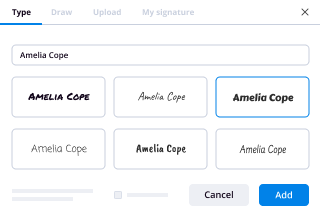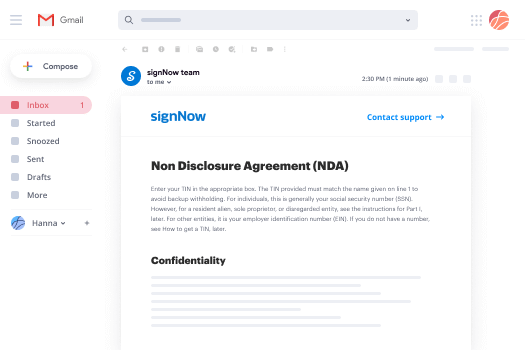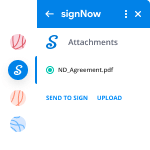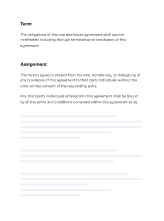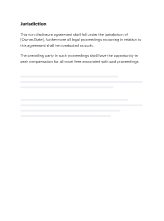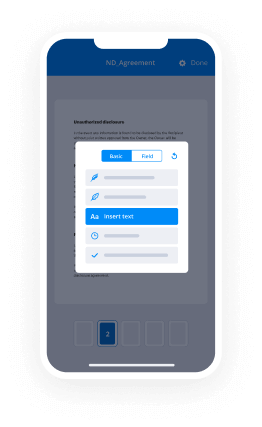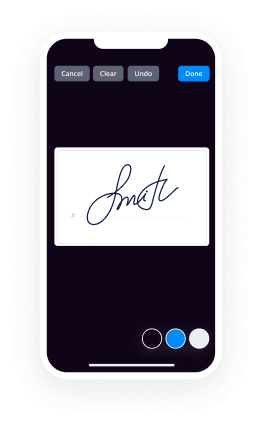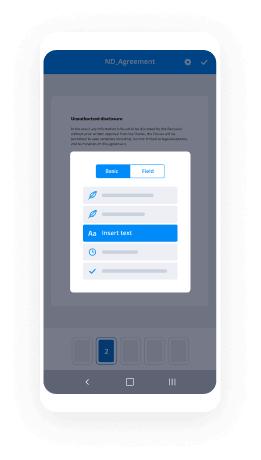1 THE [name] IRREVOCABLE EDUCATIONAL TRUST
AGREEMENT THIS IRREVOCABLE TRUST AGREEMENT made and entered into
at this _____ of ___________, 2006, by and between [XXX] of
[full address] hereinafter called the GRANTOR, and [YYY] of
Richmond, Virginia, hereinafter called the TRUSTEE. WITNESSETH:WHEREAS, the Grantor has irrevocably transferred to the
Trustee certain assets;NOW, THEREFORE, in consideration of the mutual covenants
and agreements contained herein, it is agreed that the Trustee
shall hold and administer all assets which may come into this
trust in accordance with the terms, provisions and conditions of
the within Trust Agreement.The express purpose of this trust is to provide for the
post high school education of [BBB]. ARTICLE I GENERAL PROVISIONS RELATING TO GRANTOR AND TRUSTEE 1. Irrevocability: This Trust Agreement shall be
irrevocable, and neither the Grantor nor any other person shall
have the right or power to alter, amend or revoke any of the
terms, conditions or other provisions of this Trust in whole or
in part.
2. Right to Add Property: The Grantor or any other person
may at any time cause additional real or personal property to be
added to the corpus of this Trust by deed, inter vivos transfer,
Last Will and Testament or otherwise, and the Trustee shall
hold, administer and distribute all such additional property
according to the terms and conditions of this agreement.
ARTICLE IIDISTRIBUTION In the year of the creation of this trust, and in every
succeeding calendar year thereafter in which the Grantor shall
transfer property to this trust, the Trustee shall pay
2immediately to or for the benefit of each designated beneficiary
of the Grantor who personally or through his guardian shall
request (in an instrument in writing deposited with the Trustee
no later than thirty (30) days after notice is sent to such
designated beneficiary or his representative that property has
been transferred to this trust) property of a value equal to (a)
the value, as of the date of the transfer, of the property so
transferred in the respective year divided by (b) the number of
then designated beneficiaries of the Grantor; provided, however,
that the total amount that may be so requested by such
beneficiary in each calendar year shall not exceed the greater
of five thousand dollars ($5,000.00), or the maximum gift tax
exclusion. The Trustee shall send notice in writing by mail or
deliver notice personally to each designated beneficiary
representative within thirty (30) days after it receives such
transfer. ARTICLE III POWERS AND DUTIES OF TRUSTEE Without the order, consent, approval or confirmation of any
court, person or persons, except as may be specifically required
elsewhere herein, the Trustee shall have full power and
authority to control and manage the trust estate, to collect,
recover, and receive the rents, issues, incomes, and proceeds
therefrom and to do all acts and things which the Trustee, in
the exercise of Trustee's discretion, may deem needful,
desirable, or expedient for the proper and advantageous control
thereof to the same extent and with like effect as might be done
by an individual in absolute ownership and control of said
property including, without prejudice to the generality of such
powers, the following powers:1. To compromise, settle, compound, or adjust, submit to
arbitration, or abandon on such terms as Trustee may deem
advisable, any claim or demand by or against the trust estate
and to agree to any rescission or modification of any contract
or agreement;2. To hold and retain indefinitely any portion or all of
any securities (including securities issued by any corporation
acting as Trustee hereunder) and other property of whatsoever
nature received in kind by the Trustee hereunder, including any
business owned by Grantor, without liability or responsibility
for any depreciation or loss caused thereby, so long as such
retention appears advisable, to exchange any such security or
property for other securities or properties and to retain such
items received in exchange;
33. To sell, exchange, assign, transfer and convey any
security or property, real or personal, held in the trust
estate, at public or private sale, at such time and price and
upon such terms and conditions (including credit) as the Trustee
may determine;4. To invest and reinvest in such stocks, bonds and other
securities and properties, real, personal or mixed, and wherever
situated, as the Trustee deems advisable, including stocks and
unsecured obligations, undivided interests, interests in
investment trusts, common trust funds, mutual funds (including
any such trusts or funds managed by a subsidiary, parent or
affiliate of any corporate trustee), leases on property which is
outside of my domicile, all without diversification as to kind
or amount and without being restricted in any way by any statute
or court decision (now or hereafter existing) regulating or
limiting investments by fiduciary; and, in making investments or
reinvestments, to be obligated only to use good faith and to
exercise Trustee's honest judgment as to what investments are,
from time to time, for the best interests of the trust estate
and the beneficiaries thereof, and, unless inconsistent with
other provisions of this instrument, to hold any portion of the
trust estate in cash and uninvested whenever Trustee deems such
holding to be to the ultimate advantage of the trust estate or
the beneficiaries;5. To exercise conversion, subscription, and other similar
rights pertinent to any securities at any time held hereunder,
to sell such rights, and to use such portion of the principal as
may be necessary to exercise such rights;6. To register or record and carry any property in the
name of the Trustee or in the name of a nominee without
disclosure of the trust, or to keep and retain any such
property, or any part thereof, unregistered and in such
condition that it may pass by delivery, without thereby
increasing or decreasing the Trustee's liability as fiduciary,
but no such registration, recording and/or holding by the
Trustee shall relieve the Trustee from Trustee's responsibility
for the safe custody and disposition of the trust estate in
accordance with the terms and provisions hereof;7. Unless inconsistent with other provisions of this
instrument, to consider and treat as principal the capital gains
portion of any dividend, all dividends payable in stock, all
dividends in liquidation and conversion, subscription and other
similar rights issued on securities, and to consider and treat
as income all other dividends received (except those declared as
4of a "record date" preceding death but payable after, which
shall be considered and treated as principal);8. Unless inconsistent with other provisions of this
instrument, to allocate, in Trustee's uncontrolled discretion,
all or any part of the receipts, including but not limited to
rents, capital gains, and dividends in cash, stock, or property,
to income or to principal or to both, and, in Trustee's
uncontrolled discretion, charge all or any part of the
disbursements, losses, premiums, and discounts to income or to
principal or to both, all without regard to any rule of practice
of law or equity with respect to trusts, and the decision of the
Trustee shall be binding and conclusive on all beneficiaries of
this trust and any other person or persons;9. To vote in person or by proxy any stocks or securities
held, and to grant such proxies and powers of attorney to such
person or persons as the Trustee may deem proper and to consent
in writing and join in any voting trust, pooling or depository
agreement with respect to any shares of stock forming part of
the trust estate;10. To consent to and participate in any plan for the
liquidation, reorganization, consolidation or merger of any
corporation, any security of which is held hereunder, including
the right to use any of the principal or income from the trust
estate for the payment of any charges or assessments imposed
upon the trust estate on account of its participation therein,
and to receive and continue to hold in trust any property or
securities allotted to the trust estate by reason of its
participation therein, regardless of any restrictions as to
investments contained herein;11. To lease any real estate for such term, or terms and
upon such conditions and rentals and in such manner as the
Trustee may deem advisable with or without privilege of purchase
and/or renewal (including 99 -year leases renewable forever), and
any lease so made shall be valid and binding for the full term
thereof even though same shall extend beyond the duration of the
trust; to make repairs, replacements and improvements,
structural or otherwise, to any such real estate; to insure
against fire or any other risks and to charge the expense
thereof to principal or income (or apportion same between
principal and income) as the Trustee may deem proper; to
subdivide real estate, to dedicate same to public use and to
grant easements as the Trustee may deem proper;12. Unless inconsistent with other provisions of this
instrument, whenever required or permitted to divide or
5distribute any trust property hereunder; to make distributions
or divisions (including the satisfaction of any pecuniary
bequest) in cash or in specific property, real or personal, or
an undivided interest therein, or partly in cash and partly in
such property, and to do so without regard to the income tax
basis of specific property allocated to any beneficiary
(including any trust) and without giving any such beneficiary
his proportionate share each asset available for distribution or
division. The Trustee may exercise all powers herein conferred
after the termination of any trust and until the same is fully
distributed;13. To employ accountants, attorneys and such agents and
advisors as the Trustee may deem advisable; to pay reasonable
compensation for their services and to charge same to (or
apportion same between) income and principal as the Trustee may
deem proper, and the Trustee shall not be liable for any action
taken or omitted to be taken in reliance upon the opinion or
advice of counsel, nor for the default or misconduct of any
counsel or agents or other representative selected by Trustee in
good faith;14. Unless inconsistent with other provisions of this
instrument, to hold two or more trusts or other funds in one or
more consolidated funds, in which the separate trusts or funds
all have undivided interests, or make physical division of a
single trust and hold and administer each share as a separate
trust, under the terms and conditions hereof;15. To pay out of the income and/or principal of the trust
estate all taxes, assessments, or governmental charges of any
nature whatsoever, with the exception of estate or inheritance
taxes and which may be provided for elsewhere herein, which
shall become payable in respect to the trust estate or any part
thereof or any income or profit derived therefrom and which the
Trustee, in Trustee's sole discretion, shall deem it necessary
or advisable to pay. Such payments shall be considered as a part
of the expense of administration of this trust and shall be a
charge against the income and/or principal or against any share
or portion thereof as the Trustee, in Trustee's sole discretion,
shall deem just and equitable;16. The Trustee, in Trustee's sole discretion, may contest
or prosecute any claim for refund of any tax, assessment, or
governmental charge and may pay the costs and expenses of such
contest or prosecution, including interest and penalties, if any
charged, out of the income and/or principal of the trust estate
and without any liability on Trustee's part, notwithstanding it
may be held that the Trustee contested any such tax, assessment
6or governmental charge or prosecuted a claim, for refund thereof
without reasonable cause. The Trustee shall not be liable to any
beneficiary for Trustee's failure to return any property or
income for taxation, or for Trustee's failure or omission to pay
any taxes, assessments, or governmental charge of any nature or
to make any claim for refund thereof;17. To execute and deliver any and all deeds, mortgages,
leases, contracts, agreements, bills of sale, notes, transfers,
assignments, powers of attorney, proxies, consents, waivers, and
all other documents and instruments relative to the trust estate
and assets in Trustee's hands hereunder, irrespective of the
period of duration of the trust;18. To foreclose mortgages and land contracts and to bid
for and purchase at judicial sales, any property, mortgage or
other interest, using therefor such part of the principal of the
trust estate as the Trustee may deem necessary for said purposes
and at or after maturity thereof, the Trustee may continue,
extend, modify, or renew any mortgages or land contracts which
Trustee holds hereunder;19. To join in partnerships or limited partnerships with
others for any legitimate purposes, including, but not limited
to: farming, mining, drilling, ranching, entertainment and
sports production or promotion, and real estate investment or
development;20. To do any and all things not inconsistent with the
foregoing powers and authority which the Trustee may deem
necessary, advisable, or expedient in the administration of the
trust created herein. ARTICLE IV RULE AGAINST PERPETUITIES Anything in this trust agreement to the contrary
notwithstanding, no trust created hereunder shall continue
beyond twenty-one (21) years after the death of [XXX]; and upon
the expiration of such period all trusts shall terminate and the
assets thereof shall be distributed outright to those parties
(and in the same proportions, or equally if no proportions are
stated) as are then receiving the income therefrom. ARTICLE V PROHIBITION AGAINST ALIENATION
7The interest of any beneficiary of any trust shall not be
anticipated, sold, transferred, alienated, encumbered nor in any
other manner assigned by any such beneficiary. Such interest
shall not be subject to any legal process, bankruptcy
proceedings or the interferences or control of creditors,
spouses, or divorced spouses, governments or their agencies, or
others, for the debts, obligations or activities of any
beneficiary or beneficiary's legal representative. ARTICLE VI RESIGNATION, REMOVAL OR REPLACEMENT OF TRUSTEE A. Any Trustee may resign by giving thirty (30) days
written notice to the income beneficiary not under legal
disability, or in the case of legal disability, to the legal
guardian or conservator, if any, of each income beneficiary
under legal disability, and to any Successor Trustee
specifically designated by such person or persons. For the
purpose of this article the term "income beneficiary" shall mean
a person then entitled to income from the Trust estate whether
in the discretion of the Trustee or otherwise.B. The title to the trust estate shall vest forthwith in
any Successor Trustee acting pursuant to the foregoing
provisions hereof; but any resigning or removed Trustee shall
execute all instruments and do all acts necessary to vest such
title in any Successor Trustee of record without court
accounting. A Successor Trustee shall have no duty to examine
the accounts, records and acts of the previous Trustee or
Trustees and shall in no way or manner be responsible for any
act or omission to act on the part of any previous Trustee.C. Each Successor Trustee hereunder shall have, exercise
and enjoy all of the rights, privileges and powers, both
discretionary and ministerial, as are herein and hereby given
and granted unto the original Trustee and shall incur all of the
duties and obligations imposed upon the original Trustee.D. In the event that any corporate Trustee shall at any
time become a part of any other corporation having trust powers
or shall be merged with any other such corporation or
corporations into a new corporation having trust powers, then
such corporation of which the Trustee may become a part, or
which is created by such merger, shall, without further act on
the part of any of the parties hereto, be substituted in place
and stead of the original Trustee and shall have an the rights
and powers given to the original Trustee hereunder.
8E. Any Successor Trustee appointed under the terms of this
Article shall be a bank or trust company having trust powers
under the laws of the State of Virginia. ARTICLE VIIBENEFICIARIES When the Trustee shall receive notice satisfactory to
[him/her] that [BBB] is regularly enrolled as a student in a
college, university, or other institution of collegiate grade,
the Trustee shall pay to or apply for her benefit the direct
costs of tuition, books, fees and expenses attributable to such
education including [sorority/fraternity] fees and dues, room
and board, and reasonable living expenses up to [amount] per
month so long as she is in enrolled in an institution of
collegiate grade. If [BBB] shall discontinue her studies, no
further payment will be made under this section until [month,
day, year], at which time the Trustee shall pay all the
principal and accumulated income to [BBB] and the trust shall
terminate.In the event [BBB] dies at any time prior to [month, day,
year], the Trustee or Successor Trustee shall terminate the
trust and pay all accumulated assets to [successor beneficiary]
of [city, state].This trust shall terminate upon (a) trust corpus being
fully used up for education of the beneficiary, (b) the death,
of the beneficiary, or (c) [month, day, year]. ARTICLE VIII WITHHOLDING OR POSTPONING DISTRIBUTION 1. Trustee's Discretion: Notwithstanding the foregoing
provisions of Article Seven, but subject to the limitations of
this Article, Trustee shall have the absolute discretion to
withhold or postpone any or all non-discretionary distributions
of principal to the Beneficiary or any Contingent Beneficiary if
Trustee determines, given circumstances at the time, that the
distribution should be withheld or postponed for any of the
following reasons:
a. The beneficiary is physically, mentally, or emotionally
impaired in a manner which affects the beneficiary's ability to
effectively manage the distribution;
9b. The beneficiary has a substance abuse problem which
might adversely affect the beneficiary's ability to manage the
distribution;c. The beneficiary is involved in pending, threatened or
potential litigation, bankruptcy, or insolvency proceedings, or
has other financial problems or marital difficulties which could
result in the diversion or dissipation of the distribution;d. The beneficiary is involved with a quasi-religious
organization or living in a community or under a form of
government or other conditions which would result in the
confiscation or appropriation of the distribution;e. The tax consequences to the beneficiary or the
beneficiary's estate of a distribution would be disadvantageous
to the beneficiary or the beneficiary's estate;2. Limitations on Withholding or Postponing Distributions:
The provisions in this Article authorizing withholding or
postponing distributions shall not apply to property
distributable pursuant to a beneficiary's exercise or deemed
exercise of a power of withdrawal under Article Two or property
distributable pursuant to beneficiary's exercise of a
testamentary power of appointment under this Article.
3. Administration of Withheld or Postponed Distributions
for Beneficiaries Entitled to Benefits: Trustee shall administer
any withheld or postponed distributions for a beneficiary who is
entitled to benefits from any local, state or federal government
or from any private agency as follows:
a. Uses of Net Income or Principal . Trustee may refuse to
distribute any or all of the beneficiary's share or Trustee may
distribute so much of the net income or principal of his or her
share to, or for the use or benefit of, beneficiary as in the
sole discretion of Trustee shall be necessary and proper to
provide for her extra and supplemental care, comfort, support,
maintenance and education, including vocational, rehabilitation,
technical training, in addition to and over and above the
benefits beneficiary otherwise receives from any local, state or
federal government or from any private agency. So long as
beneficiary shall be under a legal disability to act on his or
her own behalf in respect to his or her own property and
affairs, or in the judgment of Trustee is otherwise unable to
apply such payments as may be made from this Trust from time to
time to his or her own best interests, Trustee shall consult
with the guardian or other person having physical custody of
beneficiary as to any payments to be made under this Trust
10Agreement. Any income not so distributed shall be accumulated
and added to principal.b. Statement of Grantor's Intent. In exercising the
discretionary powers conferred on Trustee in this Trust
Agreement, Trustee shall be guided by the following statement of
Grantor's purpose and intentions. It is Grantor's expectation
that the trust income and principal will not be made available
to provide primary support for beneficiary. Therefore, Trustee
is directed to investigate other sources of support available to
him or her and to take whatever steps necessary to enroll
beneficiary for such benefits or assistance. Trustee is
authorized to make trust distributions to or on beneficiary's
behalf in such a way that his or her life will be enriched and
made More enjoyable, including providing recreational and
vacation opportunities for him or her. Trustee is authorized to
expend the Trust Property to procure more sophisticated medical
and/or dental treatment than may otherwise be available to
beneficiary and to seek private rehabilitative and educational
training.
c. Lifetime Care. The Trustee may, in Trustee's
discretion, obtain a lifetime care arrangement for beneficiary.
At such time as an arrangement for his or her lifetime care
shall be made and approved by a court of competent jurisdiction
(whether such arrangement be by way of commitment proceedings,
private contract or otherwise), and if the total cost of such
lifetime care is known or can reasonably be estimated, the
Trustee shall set aside an amount which, when added to any other
sums available for such purpose from whatever source, is
reasonably sufficient in Trustee's judgment to provide for such
lifetime care.
4. Conclusive Discretion of Trustee. Grantor desires
Trustee to exercise the discretionary powers conferred on
Trustee in a manner which will provide flexibility in the
administration of the Trust under conditions from time to time
existing, and in exercising powers under this Article, the
discretion of the Trustee shall be conclusive as to the
advisability of any distribution of income or principal, and as
to the person to or for whom such distribution is to be made,
and the same shall not be subject to judicial review.
IN WITNESS WHEREOF, the Grantor has executed this
instrument and the Trustee has evidenced its acceptance of the
Trust herein expressed by setting their hands and seals this
_______ of ___________________, 2004.
11 WITNESS o ur s ignatures a nd s eals: _ ____________________________Wi tness X XX G rantor __ _________________ ____________
__ _________________ ___________
Wi tness YYY TrusteeST ATE O F V IRGINIA ) ) ssC I TY/COUNTY O F _ ____ ______________ ) The f oregoing i nstrument w as a cknowledged b efore m e t his _ ___
day o f _ ____________ _____, 2 00 6, b y X XX a nd Y YY.
___________________ ________ Notary P ublic My C om mission E xpir es:______________



